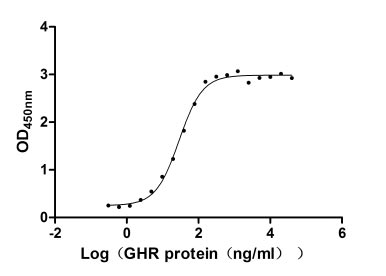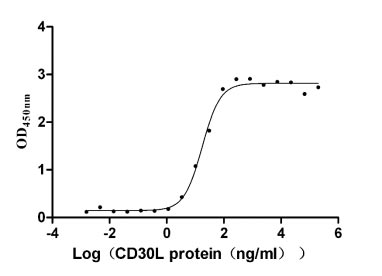Recombinant Conus textile Spasmodic peptide tx9a
-
中文名称:Recombinant Conus textile Spasmodic peptide tx9a,Yeast
-
货号:CSB-YP887929DWJ
-
规格:
-
来源:Yeast
-
其他:
-
中文名称:Recombinant Conus textile Spasmodic peptide tx9a,Yeast
-
货号:CSB-EP887929DWJ
-
规格:
-
来源:E.coli
-
其他:
-
中文名称:Recombinant Conus textile Spasmodic peptide tx9a,Yeast
-
货号:CSB-EP887929DWJ-B
-
规格:
-
来源:E.coli
-
共轭:Avi-tag Biotinylated
E. coli biotin ligase (BirA) is highly specific in covalently attaching biotin to the 15 amino acid AviTag peptide. This recombinant protein was biotinylated in vivo by AviTag-BirA technology, which method is BriA catalyzes amide linkage between the biotin and the specific lysine of the AviTag.
-
其他:
-
中文名称:Recombinant Conus textile Spasmodic peptide tx9a,Yeast
-
货号:CSB-BP887929DWJ
-
规格:
-
来源:Baculovirus
-
其他:
-
中文名称:Recombinant Conus textile Spasmodic peptide tx9a,Yeast
-
货号:CSB-MP887929DWJ
-
规格:
-
来源:Mammalian cell
-
其他:
产品详情
-
纯度:>85% (SDS-PAGE)
-
基因名:N/A
-
Uniprot No.:
-
别名:Conotoxin tx9a; Spasmodic peptide
-
种属:Conus textile (Cloth-of-gold cone)
-
蛋白长度:Cytoplasmic domain
-
表达区域:61-87
-
氨基酸序列GCNNSCQEHS DCESHCICTF RGCGAVN
-
蛋白标签:Tag type will be determined during the manufacturing process.
The tag type will be determined during production process. If you have specified tag type, please tell us and we will develop the specified tag preferentially. -
产品提供形式:Lyophilized powder
Note: We will preferentially ship the format that we have in stock, however, if you have any special requirement for the format, please remark your requirement when placing the order, we will prepare according to your demand. -
复溶:We recommend that this vial be briefly centrifuged prior to opening to bring the contents to the bottom. Please reconstitute protein in deionized sterile water to a concentration of 0.1-1.0 mg/mL.We recommend to add 5-50% of glycerol (final concentration) and aliquot for long-term storage at -20℃/-80℃. Our default final concentration of glycerol is 50%. Customers could use it as reference.
-
储存条件:Store at -20°C/-80°C upon receipt, aliquoting is necessary for mutiple use. Avoid repeated freeze-thaw cycles.
-
保质期:The shelf life is related to many factors, storage state, buffer ingredients, storage temperature and the stability of the protein itself.
Generally, the shelf life of liquid form is 6 months at -20°C/-80°C. The shelf life of lyophilized form is 12 months at -20°C/-80°C. -
货期:Delivery time may differ from different purchasing way or location, please kindly consult your local distributors for specific delivery time.Note: All of our proteins are default shipped with normal blue ice packs, if you request to ship with dry ice, please communicate with us in advance and extra fees will be charged.
-
注意事项:Repeated freezing and thawing is not recommended. Store working aliquots at 4°C for up to one week.
-
Datasheet :Please contact us to get it.
靶点详情
-
功能:In vivo, intracranial injection into mice of 10 pmol/g of the peptide induces running in circles and hyperactivity. At higher doses (50 pmol/g), the mice exhibit running and climbing symptoms for close to one hour. Between 130 and 150 pmol/g, characteristic 'spasmodic' symptomatology is elicited. A hand clap would make mice jump high and start running rapidly. When exposed to a loud hand clap, or if the cage cover were dropped, the mice lose motor control and exhibit seizure-like symptoms from which they eventually recover. At the highest doses tested (over 250 pmol/g), after the characteristic spasmodic symptomatology, lethality occurs. Injection of a similar dose range intramuscularly into Siamese fighting fish elicited no unusual symptomatology.
-
亚细胞定位:Secreted.
-
蛋白家族:Conotoxin P superfamily
-
组织特异性:Expressed by the venom duct. All different gamma-carboxyalted forms are mostly present in part 2, part 3 and part 4 of the venom duct. They are also found in part 1 (proximal part near the venom bulb) and part 5, but in lower quantity.
Most popular with customers
-
Recombinant Human Growth hormone receptor (GHR), partial (Active)
Express system: Mammalian cell
Species: Homo sapiens (Human)
-
Recombinant Human Tumor necrosis factor receptor superfamily member 8 (TNFRSF8), partial (Active)
Express system: Mammalian cell
Species: Homo sapiens (Human)
-
Recombinant Human Insulin growth factor-like family member 1 (IGFL1) (Active)
Express system: Mammalian cell
Species: Homo sapiens (Human)
-
Recombinant Macaca fascicularis Membrane spanning 4-domains A1 (MS4A1)-VLPs (Active)
Express system: Mammalian cell
Species: Macaca fascicularis (Crab-eating macaque) (Cynomolgus monkey)
-
Recombinant Human C-C chemokine receptor type 5 (CCR5)-VLPs (Active)
Express system: Mammalian cell
Species: Homo sapiens (Human)

















